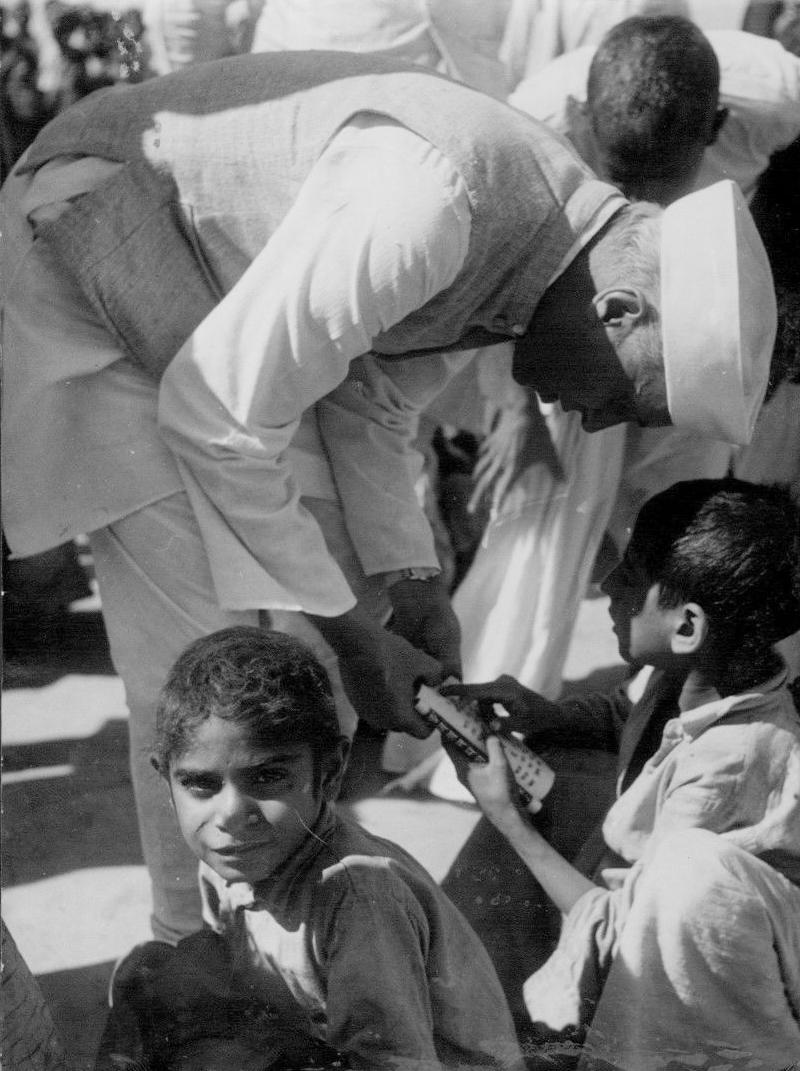
Indian and Pakistani Partition: Refugees (1947-48)

Figure 1.-- India and Pakistan had to deal with the greatest refugee crisis of the 20th century with very limited resources. Here Prime-Mimister Nehru visits with some of the refugees. The press caption read, "Nehru visits refugee camps: The Honourable Pandit Jawahara Laln Nehru, Prime-Minister of India, has just paid his first visit to the Hindu refugee camps in Krukshetrs, Eastern Punjab, where thousands of Hindu refugees from Western Punjab and Kashmore are being cared for in camps and houses. The student in an open air school which has been set up in one of the camps." The photograph was dated April 19, 1948.
|
|
Both India and Pakistan were left with huge refuge problems and few resources to deal with the needs of the displaced people, often arriving with just the clothes they were wearing on their backs. The refugees represented a huge population exchange. There were cross border movenents in both the east and west. The Muslim population in sothern India mostly stayed in place. An estimated 14.5 million decided to cross the newly created borders. The numbers moving in each direction were approximately equal. Some 7.2 million Muslims fled to Pakistan while 7.3 million Hindus and Sikhs sought refuge in India.
Women were a special case.
India
Both Sikhs and Hundus feard Muslim rule. In the west, Sikhs and Hindu Punjabis fled from the western Punjab. Most found refuge in the area of the Punjab assugned to Indiua. Others fled to Delhi. In the east, the Hindus fleeing from East Pakistan (modern Bangladesh) dispersed to a greatr degre. They settled across many areas of eastern and Northeastern India. The majority evnually ettle in the states of West Bengal, Assam, and Tripura. Some of tge refuges were settked on the lightly populated Andaman islands, Bengalis are now the largest linguistic group on the islands. The city most afected was Delhi, even more so thab Bombay. The population of Delhi essentially doubled although the refugees were not the only reaon. Housing had to be found and there was little money to build new housing. There was no Givernment effort to settle refugees in bandonedchomes. The solution was a variety of historical and military facilities. Some of tge mor important refugee camps were the Purana Qila, Red Fort, and military barracks in Kingsway Camp (now the site of Delhi University). Hre some of largest refugee camps with more than 35,000 refugees. Kurukshetra camp near Panipat was especially important. Over time, the Indian Government helped convert the camp sites into permanent housing projects. The Government financed large-scale building projects beginning in 1948. Some of these projects are: Lajpat Nagar, Rajinder Nagar, Nizamuddin East, Punjabi Bagh, Rehgar Pura, Jangpura and Kingsway Camp. The Government also funded education, employment, and business start-up loans to hlp the refugees integte into society.
Pakistan
Like the Indians there was movement in both the west and east. h movement in the west was the largest. In the west, most of those migrants did not go far, those settling in the Pakistani sector of the Punjab, originated in the neighbouring Indian regions of Punjab, Haryana and Himachal Pradesh. Others were from Jammu and Kashmir and Rajasthan. The refugees reaching Sindh were mostly Urdu-speakers (labeled the Muhajir) from the northern and central urban centers (Uttar Pradesh, Bihar, Madhya Pradesh, Gujarat and Rajasthan). The came through the Wahgah and Munabao fontiers.
Some of the Muhajirs reached Pakistan by air and ships. People from all over Sindh assembled at the Swaminarayan temple in Karachi. Muhammad Ali Jinnah visited them. Eventually mostvof the Urdu speaking refugees were settled in the port city of Karachi in the southern Sindh and in the cities of Hyderabad, Sukkur, Nawabshah and Mirpurkhas. Some of tge Urdu-speakers settled in the cities of Punjab (primarily Lahore, Multan, Bahawalpur and Rawalpindi). The number of refugees settling in the in Sindh totaled over 1.2 million anout half of went to Karachi alone. The population of the city trippled.
CIH

Navigate the Children in History Website:
[Return to Main Indian independence and partition--refugee page]
[Return to Main Indian independence and partition page]
[Return to Main Indian history page]
[Return to Main Pakistani history page]
[Return to Main Indian-Pakistani conflict page]
[Return to Main 20th century page]
[Introduction]
[Biographies]
[Chronology]
[Climatology]
[Clothing]
[Disease and Health]
[Economics]
[Geography]
[History]
[Human Nature]
[Law]
[Nationalism]
[Presidents]
[Religion]
[Royalty]
[Science]
[Social Class]
[Bibliographies]
[Contributions]
[FAQs]
[Glossaries]
[Images]
[Links]
[Registration]
[Tools]
[Children in History Home]
Created: 1:04 PM 1/18/2015
Last updated: 1:04 PM 1/18/2015



